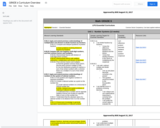
6th Grade Regular Math: Course Scope & Sequence.
- Subject:
- Mathematics
- Material Type:
- Full Course
- Provider:
- Liberty Public Schools
- Date Added:
- 08/15/2017

6th Grade Regular Math: Course Scope & Sequence.
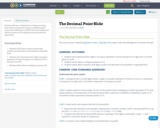
Students will use a combination of writing and using their bodies to represent numbers at different place values from 1000 down to 1/1000. They will multiply and divide by powers of 10, adding and removing zeros as appropriate.
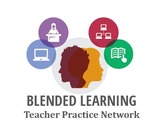
In this problem-based learning module, students will explore the importance of sleep and the impact sleep has on their lives. During the launch phase students can choose to record sleep data via downloaded apps or in a sleep diary. Days 2 through 4 have students explore the concept and necessity of living organisms need to sleep. On day 2 the participants will take a series of cognitive test for baseline data. Through station rotation and a jigsaw activity learners will become familiar with circadian rhythm and sleeping disorders. Finally, days 5-7 have the students produce a video or infographic to communicate the importance of sleep and its relationship to performance both physically and academically.
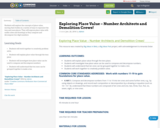
Students will explore the concepts of place value, moving their bodies in a variety of ways to represent the tens and ones places. They will express place value with unifix cubes and drawings as they compose and decompose two-digit numbers
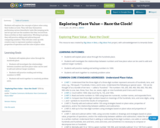
Students will explore the concepts of place value using their bodies as tools. They will time themselves performing various kinesthetic tasks like jumping jacks and sit ups and use the numbers that they record from these activities in their exploration. Working in groups, they will practice adding and subtracting and comparing numbers. They will also come up with creative ways to represent numbers using the properties of operation and the rules of place value.

Students will explore the concepts of place value using their bodies as tools. They will time themselves performing various kinesthetic tasks like jumping jacks and sit ups and use the numbers that they record from these activities in their exploration. Working in groups, they will practice adding and subtracting and comparing numbers. They will also come up with creative ways to represent numbers using the properties of operation and the rules of place value.

This learning video presents an introduction to the Flaws of Averages using three exciting examples: the ''crossing of the river'' example, the ''cookie'' example, and the ''dance class'' example. Averages are often worthwhile representations of a set of data by a single descriptive number. The objective of this module, however, is to simply point out a few pitfalls that could arise if one is not attentive to details when calculating and interpreting averages. The essential prerequisite knowledge for this video lesson is the ability to calculate an average from a set of numbers. During this video lesson, students will learn about three flaws of averages: (1) The average is not always a good description of the actual situation, (2) The function of the average is not always the same as the average of the function, and (3) The average depends on your perspective. To convey these concepts, the students are presented with the three real world examples mentioned above.
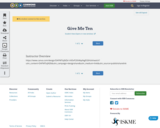
https://www.canva.com/design/DAFNF5sJNZk/-tHDvP2XX4bpfegFl26HzA/watch?utm_content=DAFNF5sJNZk&utm_campaign=designshare&utm_medium=link&utm_source=publishsharelink
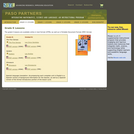
This bilingual curriculum and resources guide and is designed to help elementary school teachers organize instruction to increase achievement of Hispanic primary-grade children whose first language is not English. The guide offers a curriculum plan, instructional strategies and activities, suggested teacher and student materials, and assessment procedures. Because language development is a fundamental co-requisite for learning mathematics and science concepts, processes and skills, the lessons in many instances begin with literature (e.g., stories, books) and discussion activities that set the stage for posing questions and presenting conflicting situations related to the Big Ideas in mathematics and science that are the focus of the lesson.
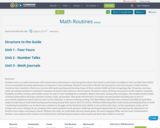
Students enter our math classrooms with anxiety about performance, misconceptions about what math is, and a lack of confidence that can limit their ability to have meaningful learning experiences. In response to this challenge, Stanford researcher Jo Boaler has focused on some key tenants to help students transform their mindset to find more success with math teaching and learning. Some of these mindset shifts include recognizing that: (1) anyone can learn math, (2) making mistakes is essential to learning, (3) math is about fluency and not speed, (4) math is visual, (5) being successful in math requires creativity, flexibility, problem solving, and number sense.
In order to start building these mindsets, Boaler advocates, among other strategies, that students build a habit of being mathematical through common routines, tasks, and puzzles.
This guide will introduce 3 of those routines/puzzles including tips on how to successfully implement these tasks in a face to face, blended, or distance learning setting.
The Need
Many adult education students had difficult (and often negative) experiences with math teaching and learning during their time in the K-12 system. Without addressing their math trauma and helping them to build a mathematical mindset, our students may continue to struggle and be limited in their ability to succeed in math class, on the equivalency exam, and in college and career settings. So our program views math mindsets as the greatest challenge and largest opportunity for transforming the experience our students have when returning to school. Without this shift, we could share the best lesson plans, the most engaging OERs, and the most transformative teachers, and students will continue to be held back by self-limiting perceptions about math and about their ability to succeed.
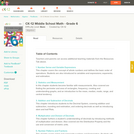
Provides teaching tips, information on common errors, differentiated instruction, enrichment, and problem solving for teachers to use with the CK-12 Middle School Math - Grade 6, Student Edition.
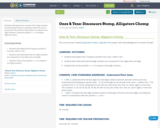
Students will explore the concept of two-digit numbers by moving their bodies to represent either the tens or ones place. They will use their bodies to compare 2 two-digit numbers, using the symbols <,=,> to compare different values.
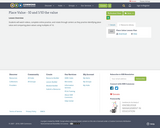
Students will watch videos, complete online practice, and rotate through centers as they practice identifying place value and comparing place values using multiples of 10.
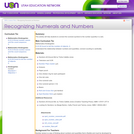
This activity will help students to connect the numeral (symbol) to the number (quantity in a set).
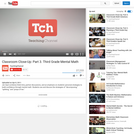
Jen Saul combines think time, partner discussions, and an emphasis on students' personal strategies to build confidence through mental math. Students use and discuss the strategies of "decomposing," "splitting," and "jumps of ten."

SYNOPSIS: In this lesson, students use a base number (1,000, 100, or 20) to compare the numbers of extinct, endangered, and vulnerable species and consider how their actions can help protect animals and plants.
SCIENTIST NOTES: This lesson lets students build their capacity to quantify and have a sense of the state of biodiversity in their community. This activity enables them to have a grip of species richness and conditions that impact biodiversity, track changes to biodiversity loss, and learn ways to protect biodiversity loss. All materials embedded in the lesson are credible. As a result, this lesson has passed our credibility review process.
POSITIVES:
-Students will consider how responsible decision-making impacts them and their environment directly.
-Students will link the math skills of writing and comparing numbers to real-life applications.
-Students at all levels of proficiency with number sense can participate using differentiated materials.
ADDITIONAL PREREQUISITES:
-This is lesson 2 of 3 in our Number Sense and Biodiversity unit.
-This lesson reinforces concepts of place value by giving students partner and independent practice. Students should already have an understanding of place value to at least 1,000 to fully engage with the materials.
-The Teacher Script can be used as a guide during the Investigate section.
-Work in the 1,000 Number Packet could be done outside of the designated time for lessons if students are working independently and the given time isn’t sufficient.
-The Number Packets include teacher keys.
DIFFERENTIATION:
-Students can work independently or in groups to complete the Number Packet.
-The Number Packet has some numbers filled in for students to stay on track. More numbers could be added for support.
-For K-1st, there is a 100 Number Packet that converts the number of species on the list to 100, instead of 1,000.
-For early kindergarten, there is a 20 Number Packet that converts the number of species on the list to 20 and does not specify by category. The packet uses simple terms such as “in danger,” “not enough information,” and “not in danger.” If you choose to use this resource, do not use the IUCN category vocabulary cards.